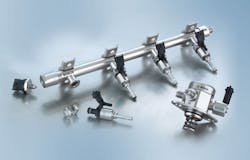In 2015, 37% of new vehicles will be manufactured with gasoline direct injection (GDI) systems, according to Robert Bosch LLC. By 2020, 49% of all new vehicles will have GDI engines.
Today’s new vehicles eventually will be in independent shops for repair and maintenance. What do dealers have to do to prepare to diagnose and repair vehicles equipped with GDI systems? Modern Tire Dealer asked two experts from Bosch, which expects to have 56% OE market share in GDI technology in 2017. Bob Pattengale, manager of training and hotline, and Stephen Albert, product manager, fuel injection and engine management, answered our questions. Both are part of Bosch’s Automotive Aftermarket North America division.
GDI technology became prevalent in new vehicles in North America in 2006, according to Albert. “The GDI system has been around a while but not into the independent aftermarket,” he says. “That system has been serviced by the dealership network. So now we are extending GDI knowledge to the technicians who are outside of that dealer network, the independent shops.”
As vehicles with GDI systems fall out of warranty, technicians are asking questions about how to service them. A different education level is needed for a technician now, according to Albert.
“It’s not as intuitive as a system. In the past there was only one fuel pump which was located in the tank. Now there’s a fuel pump that’s located on the fuel rail in addition to the one that’s in the tank. “
A GDI system is essentially a conventional port fuel injection system with a high pressure pump added to it. Technicians need to be aware of the system pressure, according to Albert. “The pressure now is upwards of 2,900 psi when going from an old pump that used to have 40 psi to anywhere up to 80 psi. To replace a fuel injector on the older style port fuel system could be anywhere from an hour to a couple hours, and the technician did not have to remove the intake manifold,” says Albert. Replacing a fuel injector on a GDI system takes much longer now.
“Today, the high pressure injector is located in the cylinder head so a technician has to remove the intake manifold and a few other ancillary products just to get to the injector,” says Albert. “So it’s anywhere from three to four times as much labor time as it used to be with the port fuel system.”
The system pressure can’t be measured with a regular gauge. A technician needs to use a scan tool to confirm the true system pressure. “The diagnostic portion and servicing portion requires a bit more system education than it did in the past. You’ve got a lot more moving parts, if you will, and you’ve got more parts that could potentially fail if not properly serviced,” says Albert.
Educate your customers on GDI service intervals
Owners of vehicles equipped with GDI systems need to be educated as well, according to Pattengale. The high pressure pump is constantly in contact metal to metal, which makes changing oil on a regular basis and using high quality oil essential to getting the best life out of a GDI vehicle. “Maintenance is critical,” he says. “Basically there’s a roller and a camshaft so people who like to extend their oil changes out for extreme lengths of time are going to end up with issues of metal fatigue because they don’t have the proper lubrication.”
Independent shops also need to explain a condition unique to some GDI vehicles to customers. Pattengale says certain car manufacturers are having issues with carbon buildup on the intake valve and in the intake area. “If the carbon is building up, then catching it early is an opportunity for the dealer to recommend an intake cleaning strategy,” says Pattengale.
He says there are several products on the market for removing carbon. “If consumers wait too long the engine will slowly over time lose power to the point the car is not performing well at all. They take it in for service but by the time it gets to that point it’s so bad that these engines have to be taken apart. Now you’re talking thousands of dollars to get the GDI vehicle back on the road. “
The customer’s driving habits determine some of the repairs and maintenance intervals for GDI vehicles. “When performing an intake cleaning strategy, depending on the customer, some customers might need to do it every year, some may need to do it every two or three years; some customers who drive really short distances may need to do it twice a year. Every consumer’s a little bit different.”
There’s no mystery to servicing GDI vehicles, according to Pattengale. Training is available from numerous providers, including Bosch. “By the time you’re done with our eight-hour class, you know what you need to do, you’re ready. You need to buy some tools, but it’s not insurmountable. You can work on these cars.” ■




